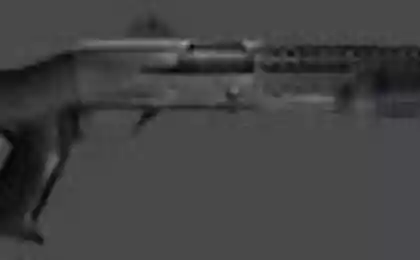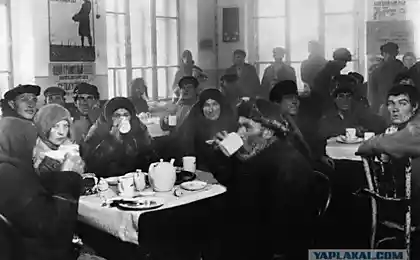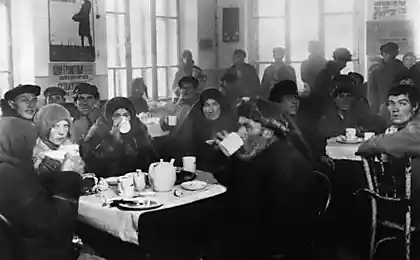1089
Multilateral machines - Part 2
Welcome YaPovchan! Earlier, I published the first part of this material.
Consider this post a double-barreled rifle pilot Olin / Winchester SALVO Assault Riffle a duplex cartridge and domestic vysokotempny gun Gennady Nikonov.
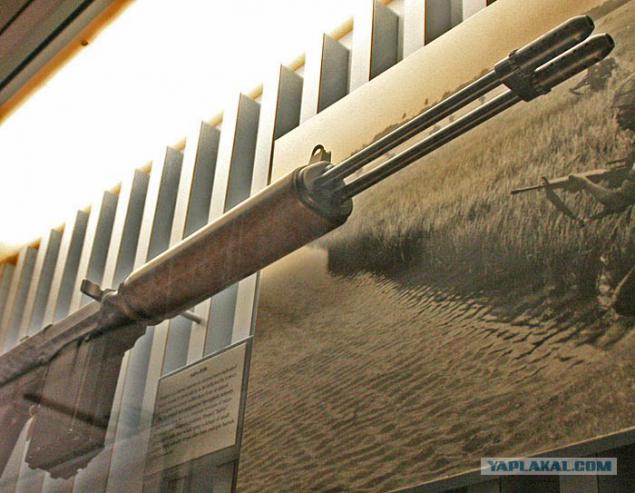
In the fifties of the last century, American gunsmiths worked on the creation of new small arms within the framework of SALVO. One of the goals of this project was a radical increase in the density of fire automatic rifles.
In pursuit of this goal designers actively experimented with duplex and triplex ammunition (more on these developments, you can read here), but the company Olin Winchester and decided to ensure compliance not only with the new cartridge, but also to develop an original rifle.
Thus, under the leadership of Stephen K. Jenson started the development of a new automatic rifle Olin / Winchester SALVO Assault Riffle.

The new rifle was to be used duplex cartridge T65, made on the basis of the sleeve holder 7, 62h51 (.308 Winchester) caliber bullets pereobzhatoy for 5 and 56 mm. The liner was charged a reduced propellant charge and one by one - two bullets.
Various ammunition used during the project SALVO, including 5, 56 T65 Duplex.
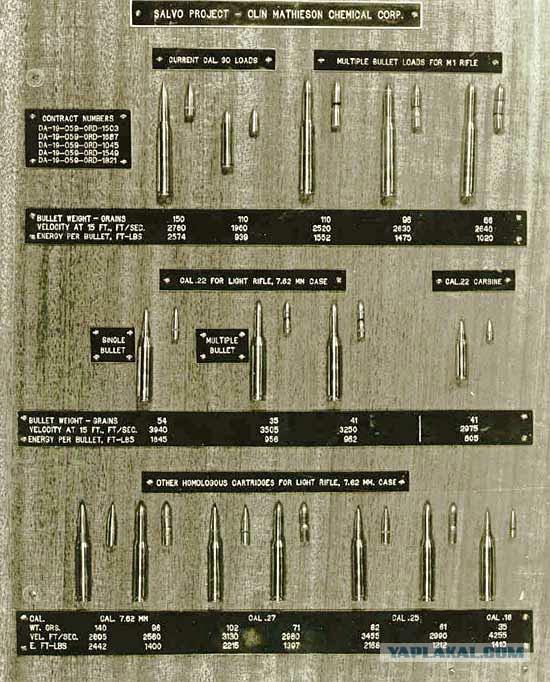
The basis of the new weapon has been taken of the Belgian FN FAL rifles development. These weapons have been borrowed some details and function of automation. At the same time, SK Jenson and his staff had to re-develop most of the details.
Designer seemed dvupulnogo cartridge is not enough to achieve the desired density of fire. Wishing to further increase the firepower of the new rifle, the sponsors made it double-barreled.
In fact, automatic rifle SALVO Assault Riffle is a block of two FN FAL, one receiver. It is similar in shape to the corresponding components of the basic FN FAL, but because of the internal mechanisms of the original was much wider.
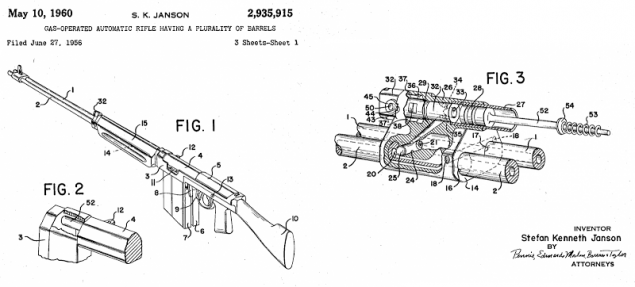
Inside the receiver is the total slide group that interacts with both barrels. The shutter has a characteristic broad shape and is equipped with two strikers and two extractors, each of which serves a barrel. Locking barrel produced skewed gate in the vertical plane. Extraction of spent cartridges is carried out through two windows in the side of the receiver. Sleeves are thrown upward and outward.
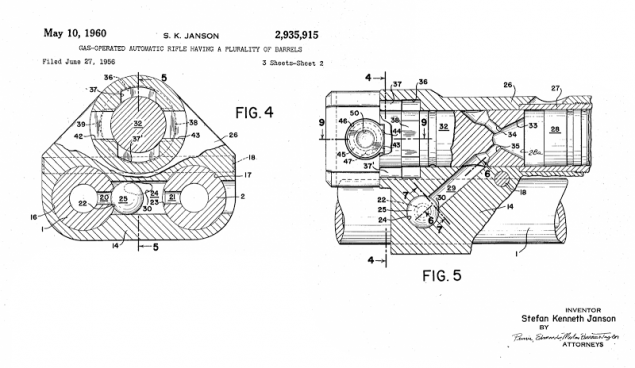
Two-caliber barrel 5, 56 mm arranged side by side and are connected to a common vapor system.
Each rifle SALVO Assault Riffle is equipped with a muzzle brake-compensator.
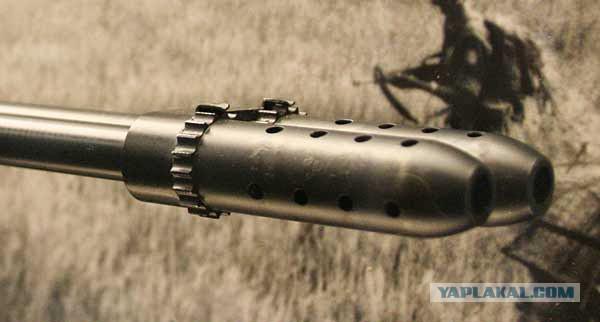
To simplify the design and operation of a new double-barreled rifles and engineers form Olin Winchester decided not to develop a new store. The ammunition supply perspective automatic rifle made of two separate box magazine 20 rounds each. Stores were no changes borrowed from the rifle FN FAL.
Each of the stores "works" only with his speed and his half barrel. Thus, if necessary, could fire arrows how both barrels, or one of them.
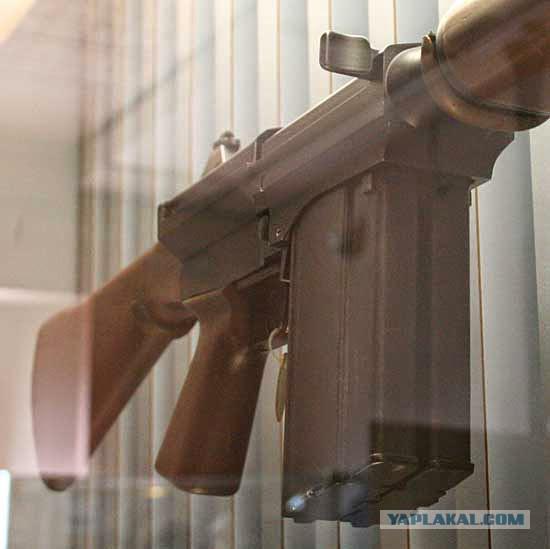
For use on the rifle Olin / Winchester SALVO Assault Riffle has developed a new fore-end, which was the basis for a similar item FN FAL. The stock and pistol grip fire control borrowed without any changes.
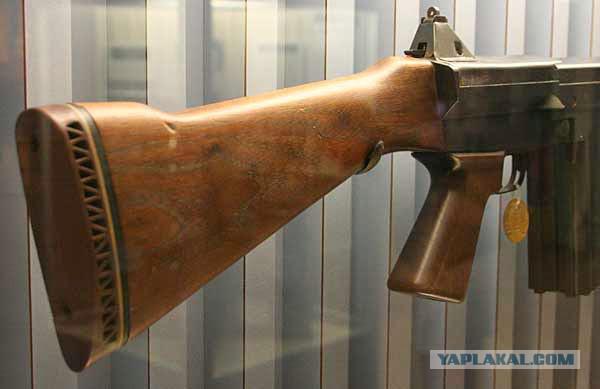
The same "origin" and have the sights. Diopter sight is located in the rear of the receiver cover, fly - over the vapor tube.
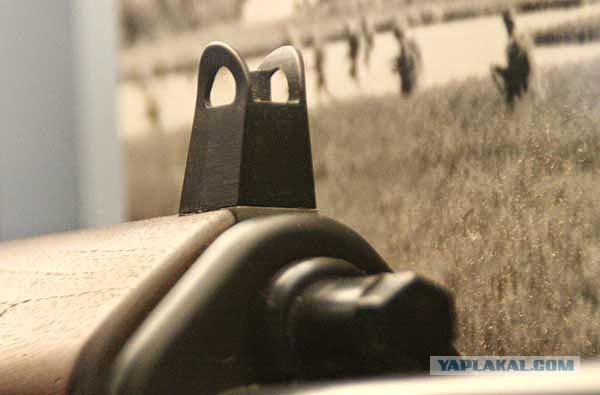
Designers have found a similar architecture perspective and suitable for use in the armed forces. In mid-February 1956 the project promising double-barreled automatic rifle from the Olin / Winchester has been tested in Springfield arsenal, and then began preparations for testing prototypes of new weapons. The first shooting took place in 1957.
During the test rifle Olin / Winchester SALVO Assault Riffle used duplex rounds T65 two types. Bullets first weighed 35 grains (2, 26 grams), the second - 41 faces (2, 65 grams). Initial velocity bullets first type reached 3505 feet per second (about 1068 m / s), a second - 3250 ft / s (990 m / s). Technical rate of two trunks reached 1300-1400 rounds per minute.
It should be emphasized, the use of two shafts in conjunction with duplex chuck enables the target to release four bullets for one automation cycle. Thus, in theory SALVO Assault Riffle could let the enemy no less than 2600 rounds per minute.
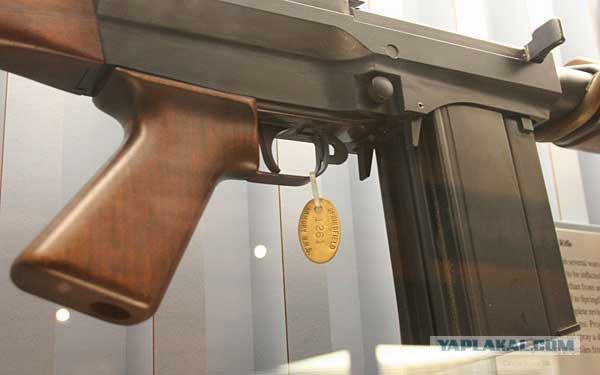
Despite the use of unusual architecture, automation, two barrels and a new cartridge, promising automatic rifle from the Olin / Winchester had to have acceptable performance accuracy. So, in 1957, it was held to check the accuracy and accuracy of fire, in which the shooter did test two stages of five shots from both barrels of a target located at a distance of 150 and 300 yards (137 and 274 meters respectively). In the first case, all the bullets 20 fit in a circle with a diameter of 7 inches (17, 8 cm). Maximum dissipation when shooting at long distances does not exceed 30 inches (76 cm 2).
Tests have shown that the automatic rifle Olin / Winchester SALVO Assault Riffle is 3-4 times greater firepower compared weapon of the same caliber, the standard odnopulny cartridge of the same caliber. This provides an acceptable accuracy, one of the preconditions to which has become a relatively low return. It was found that the double-barreled rifle recoil only a quarter higher than the carbine M1 Carbine with patron .30 Carbine (7, 62h33 mm).
Despite the relatively high performance, design firms and Olin Winchester remained experimental. The only currently known specimen of the rifles in the mid-sixties to a museum Springfield armory, where he is now.
Olin / Winchester SALVO Assault Riffle
Manufacturer - Olin / Winchester
Country - USA
Caliber - 5, 56 mm (5, 56 and T65 Duplex .22 T65 Duplex)
Weight (shops) - 4, 4 kg
Length - 1105 mm
The number of trunks - 2
Barrel length - 584 mm 2
Type of ammunition - box magazine 20 rounds
Rate - 1300-1400 rounds / min
The photo project participants. From left to right: Brig. General Ghormley, Major General Schomberg, Colonel Hurlbut.
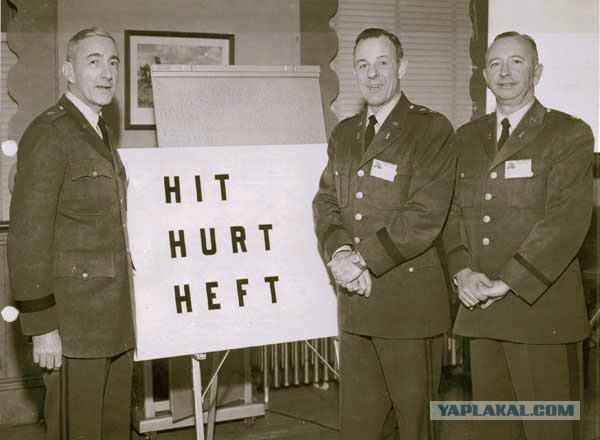
In the previous article talks about triple-machine Herman Korobov, however, the idea of increasing the number of barrels of manual automatic weapons embodied in another national development.
Sixteen years later, in 1978, to this technical solution turned Gennady Nikonov, known mainly due to its machine AN-94, created the program "Abakan".

During his tenure on the Kalashnikov Concern Gennady Nikonov created an experimental double-barreled gun vysokotempny.
As is often the case with these developments, work on his machine gun led the designer on its own initiative for the sole purpose - to check the original idea.
All units are experimental weapons placed in the receiver complex shapes. If the rear of it resembles used in Kalashnikov in front receiver has a hexagonal cross section. Cover the back of the receiver can be easily removed for cleaning and maintenance of weapons. To control the machine gun fire with a pistol grip and trigger guard. In front of them is located a receiving box for box magazine.
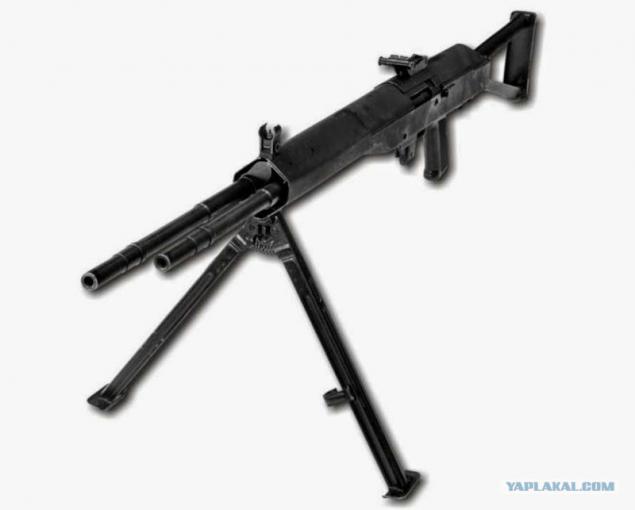
Automation experienced gun at first glance resembles a system Gusta - twin trunks and mechanical connection by means of which each of the barrel after firing recharges the second and vice versa. But weapons scheme Gusta slightly superior to a single-classic size and weight, GN Nikonov managed to create a much more compact system automation.
Two rifled barrel caliber 5, 45 mm were arranged side by side and are able to move forward and backward within 58-60 mm. To the rear of shafts mounted toothed racks cooperating with a special gear at the rear of the receiver. With this rack and pinion shafts to synchronize movements. Existing photo shows that a synchronizing gear mounted telescopic rod. Apparently, it is designed to adjust the speed of rotation of the pinion.
Before the synchronizing mechanism inside the receiver has a unit that acts as a gate in front of him, in turn, is a system of feeding cartridges into two chamber. Unlike other automatic weapons, machine gun vysokotempny Nikonov has a fixed shutter without any locking system of the barrel.
Two stem vent tube are connected to the pistons. Interestingly, the pressure of powder gases in the barrel theory should move forward. However, according to other sources, gas systems trunks were associated cross, which is why when fired from a second barrel started to move back.

Vysokotempny gun was created under the cartridge 5, 45h39 mm, and could use the appropriate stores of machines or machine guns Kalashnikov.
Because the sample was conceived as a purely experimental and intended solely for the verification of the original design, a system of ammunition considered sufficient. No attempts to modify the gun under the tape or any other food is not taken.
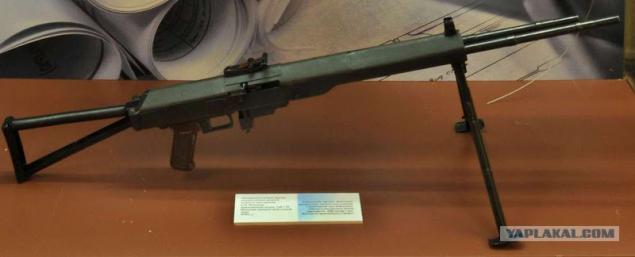
To restore the pilot was supposed to use machine guns open sight and a front sight, located in front of the receiver. Sighting devices have the most simple design, sufficient to test in a shooting range.

Before the shooting of the new weapon gunner had to pull one of the two handles charging. At the same trunk, which has been linked handle, he moves back and puts on a chambered round chambered. A second barrel at the same time moves forward. Shifts back a special projection in the barrel breech pressed on parts with complex shapes associated with the feeder cartridges. Last while moving toward the second hole and slid a new cartridge in its loading line.
When you press the trigger breakdowns trigger mechanism and drummer, located in the shutter plate, hit the primer of the cartridge in the first barrel. Powder gases from this shot fell into the vapor pipe and pressed the plunger, the barrel is shifted forward (as we have said, according to other sources, the piston moves back a second trunk). Move your rack, the first barrel of the second moved to the rearmost position. Simultaneously, by extraction and ejection of spent cartridges. Cases were thrown through two windows in the cover of the receiver. Then followed the second shot of the barrel, is launching a new cycle.
Alternately moving back and forth, and Two Smoking Barrels constantly menaced the cartridge and the shot. Application rack gear possible to achieve precise synchronization traffic trunks.
During the pilot test showed the gun vysokotempny unique to small arms firing rate. According to the estimates of test, the weapon could do over 3,000 rounds per minute, ie, about 1500 rounds per minute for each of the two shafts.
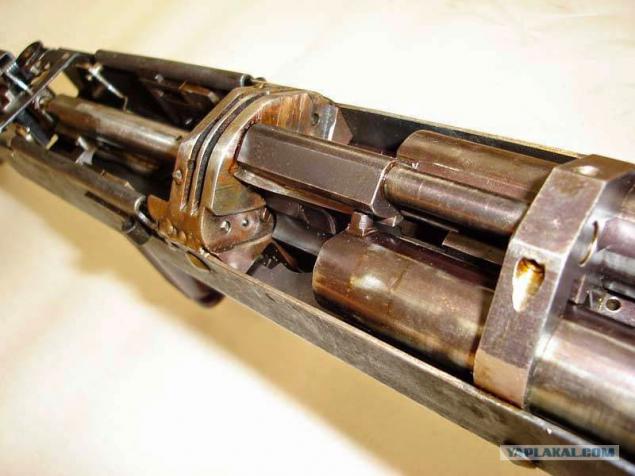
During the tests, the experimental vysokotempny gun Nikonov has demonstrated its positive side. At the same time, however, it was not without its drawbacks.
Chief among them - the low reliability of the mechanism. Due to the design used in the gears getting into the receiver of sand or mud threatened by the malfunction of the system, or even trunks synchronize its damage.
The second serious drawback design puts an end to the use of guns in the army and was associated with a high rate of fire. When at rate of 3,000 rounds per minute from a standard store of AK-30 rounds 74 consumed almost instantly. Using a slightly more capacious machine gun shops from the PKK does not affect the situation. And the introduction of the ribbon supply would require a fundamental alteration of the structure.
Thus, without many modifications on field trials could not be considered. The machine gun has successfully coped with the demonstration of the potential of the new scheme, and more of it is not required.
Currently, the only prototype vysokotempnogo Nikonov gun kept in the museum concern "Kalashnikov».
Hand gun Nikonov
Designed - 1978
Manufacturer - Kalashnikov Concern
The country - the USSR
Caliber - 5, 45 mm (5, 45 × 39 mm)
Weight (without magazine) - n \ d
Length - 1105 mm
The number of trunks - 2
Type of ammunition - sectoral store 30 rounds from an AK-74, 45 of the RPK-74, four-row by 60 rounds
Rate - 3000 rounds / min
Effective range - 1000 m
I hope it was interesting.
Taken here.
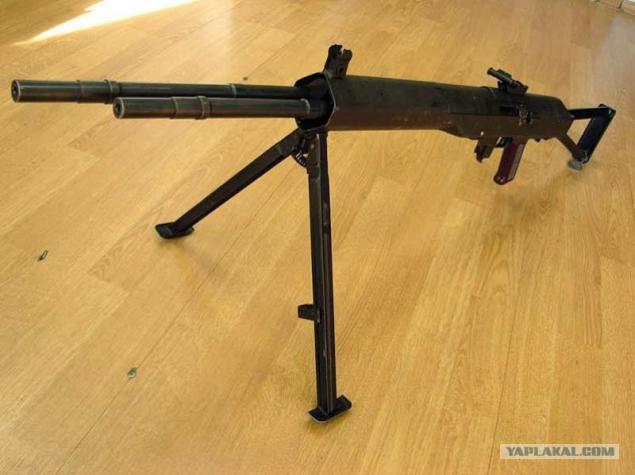
Source:
Consider this post a double-barreled rifle pilot Olin / Winchester SALVO Assault Riffle a duplex cartridge and domestic vysokotempny gun Gennady Nikonov.

In the fifties of the last century, American gunsmiths worked on the creation of new small arms within the framework of SALVO. One of the goals of this project was a radical increase in the density of fire automatic rifles.
In pursuit of this goal designers actively experimented with duplex and triplex ammunition (more on these developments, you can read here), but the company Olin Winchester and decided to ensure compliance not only with the new cartridge, but also to develop an original rifle.
Thus, under the leadership of Stephen K. Jenson started the development of a new automatic rifle Olin / Winchester SALVO Assault Riffle.

The new rifle was to be used duplex cartridge T65, made on the basis of the sleeve holder 7, 62h51 (.308 Winchester) caliber bullets pereobzhatoy for 5 and 56 mm. The liner was charged a reduced propellant charge and one by one - two bullets.
Various ammunition used during the project SALVO, including 5, 56 T65 Duplex.

The basis of the new weapon has been taken of the Belgian FN FAL rifles development. These weapons have been borrowed some details and function of automation. At the same time, SK Jenson and his staff had to re-develop most of the details.
Designer seemed dvupulnogo cartridge is not enough to achieve the desired density of fire. Wishing to further increase the firepower of the new rifle, the sponsors made it double-barreled.
In fact, automatic rifle SALVO Assault Riffle is a block of two FN FAL, one receiver. It is similar in shape to the corresponding components of the basic FN FAL, but because of the internal mechanisms of the original was much wider.

Inside the receiver is the total slide group that interacts with both barrels. The shutter has a characteristic broad shape and is equipped with two strikers and two extractors, each of which serves a barrel. Locking barrel produced skewed gate in the vertical plane. Extraction of spent cartridges is carried out through two windows in the side of the receiver. Sleeves are thrown upward and outward.

Two-caliber barrel 5, 56 mm arranged side by side and are connected to a common vapor system.
Each rifle SALVO Assault Riffle is equipped with a muzzle brake-compensator.

To simplify the design and operation of a new double-barreled rifles and engineers form Olin Winchester decided not to develop a new store. The ammunition supply perspective automatic rifle made of two separate box magazine 20 rounds each. Stores were no changes borrowed from the rifle FN FAL.
Each of the stores "works" only with his speed and his half barrel. Thus, if necessary, could fire arrows how both barrels, or one of them.

For use on the rifle Olin / Winchester SALVO Assault Riffle has developed a new fore-end, which was the basis for a similar item FN FAL. The stock and pistol grip fire control borrowed without any changes.

The same "origin" and have the sights. Diopter sight is located in the rear of the receiver cover, fly - over the vapor tube.

Designers have found a similar architecture perspective and suitable for use in the armed forces. In mid-February 1956 the project promising double-barreled automatic rifle from the Olin / Winchester has been tested in Springfield arsenal, and then began preparations for testing prototypes of new weapons. The first shooting took place in 1957.
During the test rifle Olin / Winchester SALVO Assault Riffle used duplex rounds T65 two types. Bullets first weighed 35 grains (2, 26 grams), the second - 41 faces (2, 65 grams). Initial velocity bullets first type reached 3505 feet per second (about 1068 m / s), a second - 3250 ft / s (990 m / s). Technical rate of two trunks reached 1300-1400 rounds per minute.
It should be emphasized, the use of two shafts in conjunction with duplex chuck enables the target to release four bullets for one automation cycle. Thus, in theory SALVO Assault Riffle could let the enemy no less than 2600 rounds per minute.

Despite the use of unusual architecture, automation, two barrels and a new cartridge, promising automatic rifle from the Olin / Winchester had to have acceptable performance accuracy. So, in 1957, it was held to check the accuracy and accuracy of fire, in which the shooter did test two stages of five shots from both barrels of a target located at a distance of 150 and 300 yards (137 and 274 meters respectively). In the first case, all the bullets 20 fit in a circle with a diameter of 7 inches (17, 8 cm). Maximum dissipation when shooting at long distances does not exceed 30 inches (76 cm 2).
Tests have shown that the automatic rifle Olin / Winchester SALVO Assault Riffle is 3-4 times greater firepower compared weapon of the same caliber, the standard odnopulny cartridge of the same caliber. This provides an acceptable accuracy, one of the preconditions to which has become a relatively low return. It was found that the double-barreled rifle recoil only a quarter higher than the carbine M1 Carbine with patron .30 Carbine (7, 62h33 mm).
Despite the relatively high performance, design firms and Olin Winchester remained experimental. The only currently known specimen of the rifles in the mid-sixties to a museum Springfield armory, where he is now.
Olin / Winchester SALVO Assault Riffle
Manufacturer - Olin / Winchester
Country - USA
Caliber - 5, 56 mm (5, 56 and T65 Duplex .22 T65 Duplex)
Weight (shops) - 4, 4 kg
Length - 1105 mm
The number of trunks - 2
Barrel length - 584 mm 2
Type of ammunition - box magazine 20 rounds
Rate - 1300-1400 rounds / min
The photo project participants. From left to right: Brig. General Ghormley, Major General Schomberg, Colonel Hurlbut.

In the previous article talks about triple-machine Herman Korobov, however, the idea of increasing the number of barrels of manual automatic weapons embodied in another national development.
Sixteen years later, in 1978, to this technical solution turned Gennady Nikonov, known mainly due to its machine AN-94, created the program "Abakan".

During his tenure on the Kalashnikov Concern Gennady Nikonov created an experimental double-barreled gun vysokotempny.
As is often the case with these developments, work on his machine gun led the designer on its own initiative for the sole purpose - to check the original idea.
All units are experimental weapons placed in the receiver complex shapes. If the rear of it resembles used in Kalashnikov in front receiver has a hexagonal cross section. Cover the back of the receiver can be easily removed for cleaning and maintenance of weapons. To control the machine gun fire with a pistol grip and trigger guard. In front of them is located a receiving box for box magazine.

Automation experienced gun at first glance resembles a system Gusta - twin trunks and mechanical connection by means of which each of the barrel after firing recharges the second and vice versa. But weapons scheme Gusta slightly superior to a single-classic size and weight, GN Nikonov managed to create a much more compact system automation.
Two rifled barrel caliber 5, 45 mm were arranged side by side and are able to move forward and backward within 58-60 mm. To the rear of shafts mounted toothed racks cooperating with a special gear at the rear of the receiver. With this rack and pinion shafts to synchronize movements. Existing photo shows that a synchronizing gear mounted telescopic rod. Apparently, it is designed to adjust the speed of rotation of the pinion.
Before the synchronizing mechanism inside the receiver has a unit that acts as a gate in front of him, in turn, is a system of feeding cartridges into two chamber. Unlike other automatic weapons, machine gun vysokotempny Nikonov has a fixed shutter without any locking system of the barrel.
Two stem vent tube are connected to the pistons. Interestingly, the pressure of powder gases in the barrel theory should move forward. However, according to other sources, gas systems trunks were associated cross, which is why when fired from a second barrel started to move back.

Vysokotempny gun was created under the cartridge 5, 45h39 mm, and could use the appropriate stores of machines or machine guns Kalashnikov.
Because the sample was conceived as a purely experimental and intended solely for the verification of the original design, a system of ammunition considered sufficient. No attempts to modify the gun under the tape or any other food is not taken.

To restore the pilot was supposed to use machine guns open sight and a front sight, located in front of the receiver. Sighting devices have the most simple design, sufficient to test in a shooting range.

Before the shooting of the new weapon gunner had to pull one of the two handles charging. At the same trunk, which has been linked handle, he moves back and puts on a chambered round chambered. A second barrel at the same time moves forward. Shifts back a special projection in the barrel breech pressed on parts with complex shapes associated with the feeder cartridges. Last while moving toward the second hole and slid a new cartridge in its loading line.
When you press the trigger breakdowns trigger mechanism and drummer, located in the shutter plate, hit the primer of the cartridge in the first barrel. Powder gases from this shot fell into the vapor pipe and pressed the plunger, the barrel is shifted forward (as we have said, according to other sources, the piston moves back a second trunk). Move your rack, the first barrel of the second moved to the rearmost position. Simultaneously, by extraction and ejection of spent cartridges. Cases were thrown through two windows in the cover of the receiver. Then followed the second shot of the barrel, is launching a new cycle.
Alternately moving back and forth, and Two Smoking Barrels constantly menaced the cartridge and the shot. Application rack gear possible to achieve precise synchronization traffic trunks.
During the pilot test showed the gun vysokotempny unique to small arms firing rate. According to the estimates of test, the weapon could do over 3,000 rounds per minute, ie, about 1500 rounds per minute for each of the two shafts.

During the tests, the experimental vysokotempny gun Nikonov has demonstrated its positive side. At the same time, however, it was not without its drawbacks.
Chief among them - the low reliability of the mechanism. Due to the design used in the gears getting into the receiver of sand or mud threatened by the malfunction of the system, or even trunks synchronize its damage.
The second serious drawback design puts an end to the use of guns in the army and was associated with a high rate of fire. When at rate of 3,000 rounds per minute from a standard store of AK-30 rounds 74 consumed almost instantly. Using a slightly more capacious machine gun shops from the PKK does not affect the situation. And the introduction of the ribbon supply would require a fundamental alteration of the structure.
Thus, without many modifications on field trials could not be considered. The machine gun has successfully coped with the demonstration of the potential of the new scheme, and more of it is not required.
Currently, the only prototype vysokotempnogo Nikonov gun kept in the museum concern "Kalashnikov».
Hand gun Nikonov
Designed - 1978
Manufacturer - Kalashnikov Concern
The country - the USSR
Caliber - 5, 45 mm (5, 45 × 39 mm)
Weight (without magazine) - n \ d
Length - 1105 mm
The number of trunks - 2
Type of ammunition - sectoral store 30 rounds from an AK-74, 45 of the RPK-74, four-row by 60 rounds
Rate - 3000 rounds / min
Effective range - 1000 m
I hope it was interesting.
Taken here.

Source:


